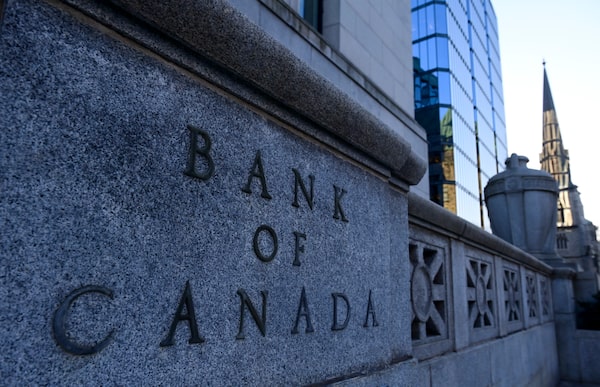
The Bank of Canada in Ottawa on Tuesday, Dec. 15, 2020. THE CANADIAN PRESS/Sean KilpatrickSean Kilpatrick/The Canadian Press
The Bank of Canada’s key policy rate is once again being scrutinized ahead of the monetary policy announcement on Wednesday, as recent comments by members of the bank’s governing council have fueled speculation of a possible “microcut” to the target rate.
Few economists and market analysts expect the central bank to trim its overnight target rate on Wednesday. But they say the possibility can’t be ruled out as the bank tries to balance the near-term pain of lock-downs against better-than-expected vaccine news and robust fiscal stimulus.
Discussion of the overnight rate has been muted over the course of the pandemic. At the outset of the crisis, the bank cut its policy rate to 0.25 per cent from 1.75 per cent, which it said was the “effective lower bound” beneath which financial markets could start to seize up.
Since then, it has repeatedly said that it expects to keep the target rate at the effective lower bound until inflation “sustainably” returns to 2 per cent. The bank said in October that it does not expect this to happen until 2023, all but ruling out a rate increase in the short to medium-term.
In November, however, bank Governor Tiff Macklem raised the possibility that the effective lower bound could in fact be below 0.25 per cent while still staying above zero, opening the door to a possible microcut to 0.10 per cent or 0.15 per cent. Economists use the term microcut when the central bank drops rates in increments less than a typical quarter of a percentage point.
Deputy-governor Paul Beaudry reiterated the idea in a December speech, as COVID-19 cases were on the rise, saying that the bank could reassess the effective lower bound “should things take a more persistent turn for the worse.”
Bond traders reacted to the comments, and market-based gauges of rate expectations declined, pointing to a possible rate cut in January.
“Central bankers are not in the business of just saying ‘stuff’ for fun - everything has a meaning,” Ian Pollick, global head of fixed income, currency and commodities strategy at CIBC Capital Markets, wrote in a note to clients last week
“The fact that two senior members of the Governing Council have commented that the effective lower bound may be ‘lower’ than previously assumed suggests, at the very least, the Bank is currently ruminating on the impact a lower base-rate may have on the economy and the financial system,” he wrote.
The key question heading into Wednesday’s announcement is whether the spike in COVID-19 cases and the new round of strict lockdown measures in provinces like Quebec and Ontario amounts to a “persistent turn for the worse” in the eyes of the bank’s governing council.
Bank of Canada watchers are largely of the opinion that the current conditions do not warrant a microcut. Eight of nine members of The C.D. Howe Institute’s Monetary Policy Council – a combination of bank economists and academics – suggested last week that the bank should keep its overnight rate at 0.25 per cent. Bank analysts took a consistent line against a microcut in reports published last week.
Things are certainly looking grim in the short-term, with first-quarter growth forecasted to turn negative and the most recent Statistics Canada jobs report showing the first decline in jobs since April.
That said, the bank tends to look past short-term data when making policy decisions, and several things have improved markedly since it laid out its last economic projections in October’s Monetary Policy Report. Two COVID-19 vaccines have been approved in Canada, oil prices are rising, and both the Canadian and U.S. federal governments have announced significant amounts of new fiscal stimulus – all of which points to increasing inflation expectations in the medium-term.
“Never say never, but I think it’s pretty low odds they do the micro-cut,” Derek Holt, head of capital markets economics at Scotiabank, said in an interview. “I think the bank will say, ‘sure we’re getting weaker news now and developments, but there’s still cause for optimism, with the amount of stimulus and vaccines coming.”
The bank’s quantitative easing program is the other key variable in Wednesday’s announcement. The bank is buying $4-billion worth of Government of Canada bonds every week in an attempt to keep yields low. It reduced its pace of weekly bond buying from $5-billion to $4-billion in October, and analysts expect the bank to further reduce its purchases in the coming months.
“At this point I think it’s steady as she goes on the QE program,” Benjamin Reitzes, director of Canadian rates at BMO Capital Markets, said in an interview.
“They’re going to wait for more information on how the [bond] issuance outlook is going to evolve, so we’ll have to wait for a [federal] budget which will come March or April,” Mr. Reitzes said.
Your time is valuable. Have the Top Business Headlines newsletter conveniently delivered to your inbox in the morning or evening. Sign up today.